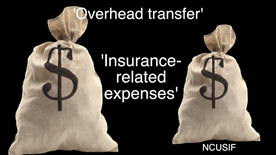Video details how OTR works
Posted July 22, 2015CONTACT: Patrick Keefe, NASCUS Communications/(703) 528-5974; [email protected]
VIDEO DETAILS HOW THE ‘OVERHEAD TRANSFER RATE’ WORKS
Purpose, mechanics of OTR outlined in brief presentation
A brief video that explains the purpose and mechanics of the “overhead transfer rate” (OTR) – including the impact of the OTR on state-chartered credit unions — has been developed and posted on the web by NASCUS.

The OTR is the ratio that NCUA applies in transferring money from the National Credit Union Insurance Fund (NCUSIF) to the agency’s operating fund to cover “insurance-related expenses.” In 2015, about 72 percent of the agency’s operating expenses are covered by the OTR. (Click on the image – or below – to launch the video.)
In addition to describing how the OTR works, the NASCUS 1.25-minute video also specifically notes that:
- While the OTR has been expanding over the last three years, federal credit union (FCU) operating fees have declined over that period by $14.3 million;
- That has, in turn, reduced FCU out-of-pocket expenses;
- Giving FCUs a singular advantage, and negatively affecting the competitive position of state-chartered credit unions relative to FCUs.
“We settled on this approach to afford a simple and concise way to explain the OTR,” said NASCUS President and CEO Lucy Ito. “The OTR is a crucial issue to our members, as it has important implications to the balance of the dual-chartering system.”
In June, NASCUS released a legal analysis conducted by a Washington, D.C., law firm, which concluded that the OTR is a “major rule” and is subject to notice and comment requirements under federal law.
“As the analysis points out, by shifting a portion of federal credit unions’ share of NCUA expenses to the NCUSIF, the OTR reduces out-of-pocket expenses incurred by federal credit unions,” Ito said. “Our fundamental point is that the resulting reduction in federal credit union operating fees provides a singular advantage to those credit unions, and adversely affects the competitive position of state charters relative to federal charters.”
You can view the video here. The NASCUS legal analysis is available here.
For more information about NASCUS's news and/or public relations, please contact our Marketing and Communications Department.